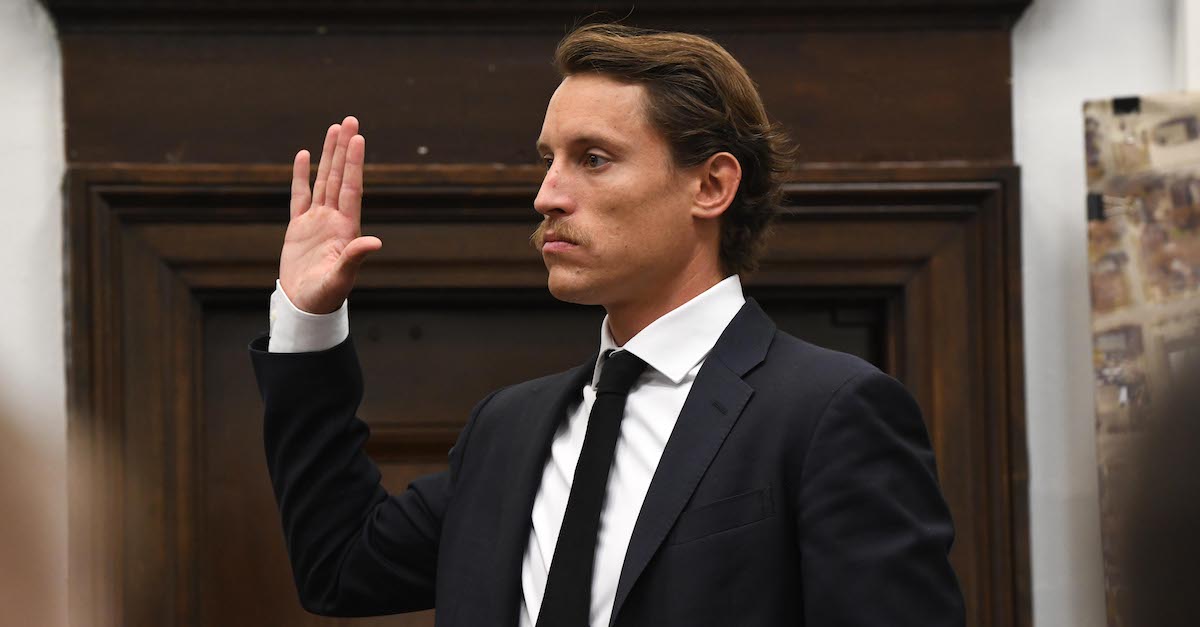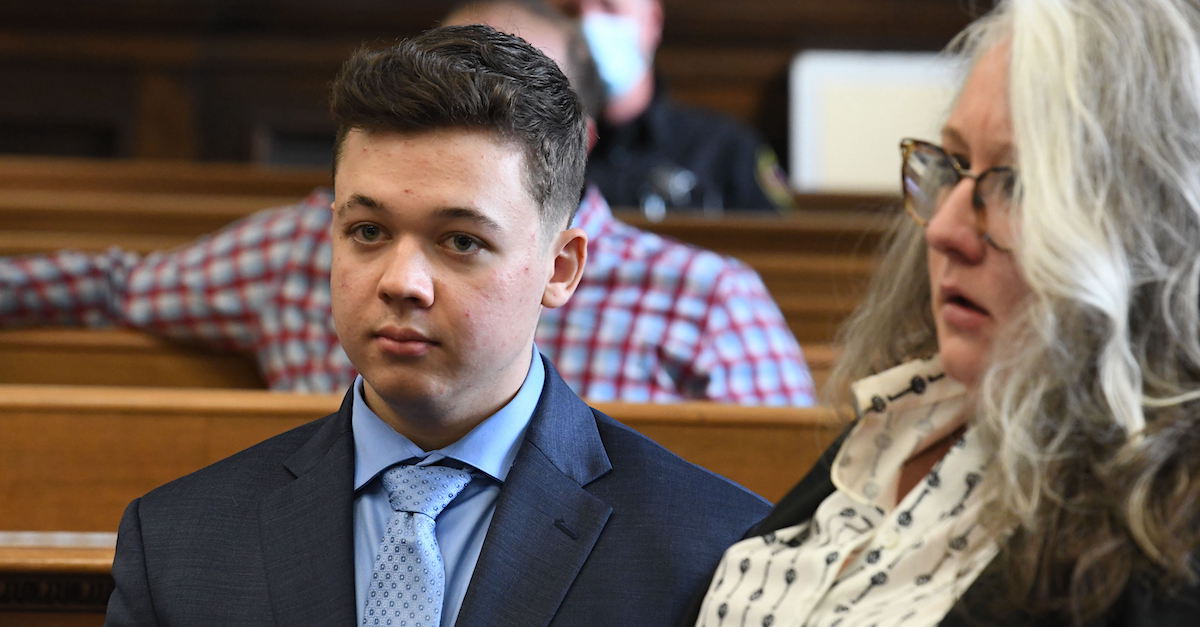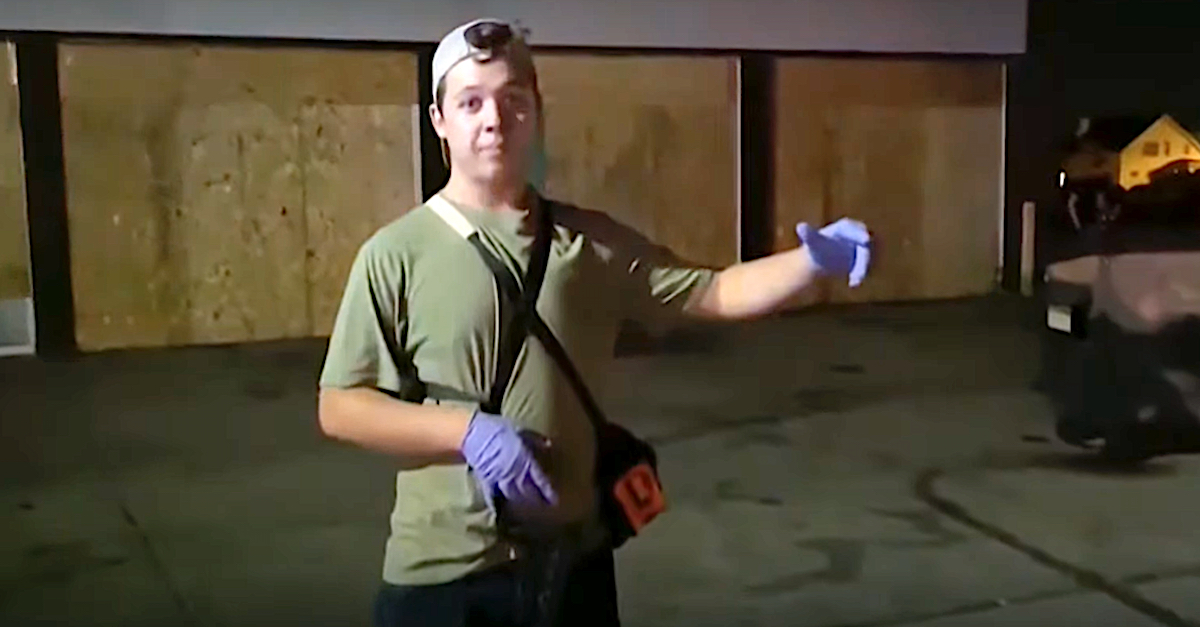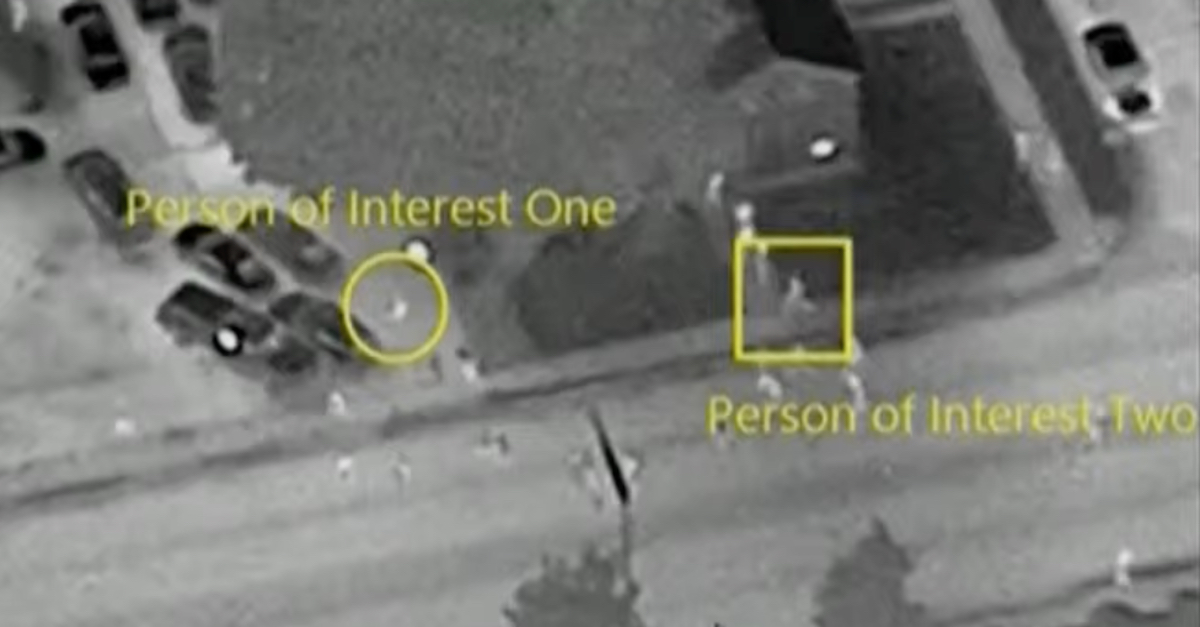
Richie McGinniss, the chief video director for the Daily Caller, takes an oath before testifying in the Kyle Rittenhouse murder trial on Thurs., Nov. 4, 2021.
The chief video director for The Daily Caller, a conservative website founded by Tucker Carlson, testified during the intentional homicide trial of Kyle Rittenhouse that he witnessed the events which led to the deadly shooting of Joseph Rosenbaum — and then saw the actual shooting itself. Prosecutors tried to suggest that Richie McGinniss, the video director, was changing his story compared with previous interviews about what occurred; McGinniss said that Rosenbaum’s “momentum” was moving toward Rittenhouse when Rittenhouse fired.
“Would you consider yourself a journalist?” asked prosecutor Thomas Binger shortly after McGinniss took the stand.
“I would consider myself somebody who works alongside journalists every day,” McGinniss said. He described his role primarily as that of a facilitator who ensured that video was properly processed and disseminated alongside the work of others.
McGinniss said he obtained a bachelor’s degree in Middle Eastern history from Georgetown but did not describe any formal training in journalism.
Binger asked who founded the Daily Caller. McGinniss named Carlson and Neil Patel. Patel is still involved with the site; Carlson is not.
McGinniss testified the work of two Daily Caller reporters “were able to capture aspects of what was going on that I didn’t see elsewhere in the media” and that he wished to “show the public a side of what was happening that the corporate press wasn’t keen to show.”
McGinniss said he was on the ground for protests in Seattle, Portland, Washington, D.C., New York, and Kenosha in the aftermath of George Floyd’s death.
“It was very clear to us that while . . . cable news correspondents would go in and say what was going on, and then they’d leave and go back to their hotels,” McGinniss said. “We just hung out in these places for hours and hours on end, and we just used our phones to show the public what was happening.”
McGinniss described “a lot of clashing with law enforcement,” including the projection of “incendiary devices” at police, in the various cities he traveled to observe.
At one point, he said the crowd turned on him in New York. He said he “bear hugged” a female reporter and “dragged her out” of the situation. He said he was ultimately not injured in that incident but said her was in others. He did not go into further detail.
McGinniss described seeing “armed individuals” protecting various businesses in Kenosha. He said some people were putting out fires lit by protesters with power washers. McGinniss said the attempts to extinguish the flames were directed at one particular business.
“Fires were out of control at that point,” Binger noted.

Kyle Rittenhouse appears in court next to defense attorney Natalie Wisco.
The next day, McGinniss interviewed business owners whose locations were damaged by the violence. That night, McGinniss said his team returned to document protests at the Kenosha courthouse. When the police pushed people away from that location, he ended up at another location where violence ensued.
“I was in the middle of the protesters on one side and the police on the other,” McGinniss said. He recorded “bricks” being thrown at police.
“There was no cell service,” he said, so he returned to his hotel to transmit data back to Daily Caller headquarters in Washington, D.C. During that process, he saw additional armed individuals outside the business that was torched the previous night. He said he “dropped” what he was doing during the upload to record the “escalated” situation involving the armed individuals.
The business was the Car Source location at the southwest corner of 59th and Sheridan. Rittenhouse was there.
“Any time that there are guns, that elevates the level of danger in my mind,” McGinniss said. “I’ve been to — like I said — across the country to many protests. People have guns; there’s a lot of people in a confined space. These are the kinds of situations where everybody’s passionate about why they’re out there. In my mind . . . the presence of weapons meant that . . . I should be on the ground” and that his team was “as close together as possible” to remain safe.
He confirmed that the “presence of guns” made him worry about the “safety of his reporters.”
McGinniss said he had personally fired the type of weapon carried by Rittenhouse.
He approached the location where Rittenhouse was located. There, he approached some of those carrying guns for interviews. Rittenhouse volunteered to speak with him.
Binger forced McGinniss to admit that he once described the individuals there as “menacing.” McGinniss said he was referring to the elevated risk caused by the presence of the weapons.
“I don’t know the exact definition of the word ‘menacing,'” McGinniss clarified. “I was using it in a live interview.”
McGinniss said Rittenhouse characterized himself as an “adult” when he asked the defendant his age. McGinniss said the issue of the defendant’s age was relevant because he needed the permission of parents to record a minor.

Kyle Rittenhouse speaks to Richie McGinniss of the Daily Caller on Aug. 25, 2020. The recording was entered into evidence on Nov. 4. 2021, in Rittenhouse’s trial. (Image via screengrab from the Law&Crime Network)
“People are getting injured, and our job is to protect this business,” Rittenhouse told him in the subsequent recording. “Part of my job is to also help people. If there’s somebody hurt, I’m running into harm’s way.”
Rittenhouse was wearing purple latex gloves and a green shirt. He said other gunners were there to help protect him.
“We’re running medical,” Rittenhouse continued. “We’re going in, and we’re getting people.”
Rittenhouse said he was “from the area.” He lived in Antioch, Ill., but the defense said he worked nearby and had significant connections to Kenosha.
He said he was carrying his rifle to protect himself when he was engaging in alleged medical rescue missions.
He said his goal was to “provide medical attention.”
“If you get hurt, I’m grabbing you,” Rittenhouse said.
He also said he “deescalated” a situation at a church and extinguished a fire at a school.
“I feel like there would be a lot more casualties” if the police acted, Rittenhouse said in the recording. He claimed local professional medical crews were not entering the area.
McGinniss said he followed Rittenhouse and others because they appeared to be embarking on the mission they professed to be carrying out.
“He’s an EMT,” Ryan Balch, a trial witness and companion who was walking behind Rittenhouse, said while pointing at the defendant.
“So, you’re a certified EMT?” McGinniss asked Rittenhouse.
“Yep,” Rittenhouse said.
When asked if he was employed as an EMT normally, Rittenhouse said he was “a lifeguard normally” but had some other qualifications.
After stopping the video, Binger asked McGinniss to clarify what was difficult to hear on the video. McGinniss said Rittenhouse claimed to have lifeguard certifications. McGinniss said he has not come across medics armed with AR-15-style rifles at any other protests and only once recalled seeing “a medic armed with a handgun” in Seattle.
When the video resumed, Balch reacted to what McGinniss described as a brick or a portion of a brick that was thrown in the vicinity.
“Does anybody need medical?” Rittenhouse yelled out into the night several times.
McGinniss testified that a group of protesters he approached complained that Rittenhouse allegedly pointed his rifle at them. He didn’t conduct a formal interview with the group because several members carried rocks; one had a handgun. McGinniss said their demeanor suggested they did not want to be recorded. McGinniss said he was not armed.
Binger noted that all of the individuals were Black.
“The way that the one stepped out on me, it was like he was presenting the rocks as if he was ready to smash my head, and he stepped out in my direction, at which point I kind of took one step back,” McGinniss testified. “In those situations, I’m just trying to keep my distance.”
McGinniss said he attempted to offer the group a few cans of White Claw, an alcoholic seltzer, and cigarettes as icebreakers. He said one member of the group accepted a White Claw and that the group started to make fun of him for being scared. He said the icebreakers diffused the tension.
The group complained that Rittenhouse pointed his gun at them when they were “jumping on some cars.”
Rittenhouse suddenly started running down the street carrying a fire extinguisher, so McGinniss cut short the conversation to follow Rittenhouse.
People were yelling the “n-word,” McGinniss said. Rittenhouse and the first man he shot, Joseph Rosenbaum, encountered one another in a “crowd of people.”
Binger played a recording from an FBI plane that showed Rittenhouse running after Rosenbaum, then Rosenbaum chasing Rittenhouse.

A still frame from an FBI surveillance plane shows who prosecutors say was Kyle Rittenhouse (framed by a square) running toward Joseph Rosenbaum (framed by a circle). Their positions reversed; Rosenbaum ran after Rittenhouse before Rittenhouse eventually killed Rosenbaum. (Image via evidence exhibit/the Law&Crime Network.)
Rosenbaum was “advancing on” Rittenhouse, the McGinnis said revealed. Rittenhouse “pivoted” and ran. Rosenbaum followed; McGinniss did as well.
McGinniss said he was about 15 feet away from the action. He attempted to record what he was seeing but accidentally took a still photo during the commotion and not a video recording.
McGinniss said he believed Rosenbaum was unarmed. He said Rosenbaum said “f you” but clarified when pressed that he didn’t realize who uttered the words until after he’d reviewed other recordings of the incident.
Prosecutor Binger repeatedly told McGinniss to focus on what he personally recalled in the moment and without the benefit of hindsight or additional reviews of evidence.
McGinniss said he “heard things said” but couldn’t perceive who was saying what because his focus was on the barrel of Rittenhouse’s gun. He said Rosenbaum attempted to corner Rittenhouse in a “dead end” of other obstructions.
He said Rosenbaum and Rittenhouse were going to “collide” and that he sought to get “out of harm’s way.” He said Rittenhouse turned around, that Rosenbaum “was continuing to advance,” and that Rosenbaum was “lunging toward the front portion of the rifle.”
“It was clear to me that something with the weapon was about to happen,” McGinniss continued. “It wasn’t clear to me whether the weapon would be grabbed or fired or what exactly was going to happen, but it was clear to me that it was a situation where it was likely that something dangerous was going to happen, be it Mr. Rosenbaum grabbing it, Mr. Rittenhouse shooting it. I didn’t know, but I knew that my eyes at that moment were — in this exact moment — fixated on the barrel of the weapon because I didn’t want to end up on the receiving end of that.”
Binger asked where the weapon was pointed.
He said it was angled at about 45 degrees toward the ground. When Rosenbaum “lunged,” Rittenhouse “leveled and fired,” McGinniss testified.
McGinniss alternated between saying Rosenbaum “made contact” with Rittenhouse or whether Rosenbaum “missed” touching the defendant or his gun.
“He basically fell forward,” McGinniss said of Rosenbaum. “It was as if you were to lunge at somebody, they’d probably stop themselves from falling face down on the ground, but the shots were fired in the exact instance that his momentum was going forward, and that continued until Mr. Rosenbaum landed on the ground.”
Rosenbaum was face down on the ground after he was shot, McGinniss said. McGinnis said it was “not clear” whether Rosenbaum fell because he was shot or before he was shot. What was clear, he said was that Rosenbaum’s overall “momentum” was toward Rittenhouse.
Binger asked why McGinniss previously said Rosenbaum was shot while falling. The prosecutor played a Fox News interview between McGinniss and Tucker Carlson where McGinniss said Rosenbaum was “lunging” and then “falling” as Rittenhouse “dodged around” with the barrel of the gun and eventually pulled the trigger.
McGinniss pondered the sequence of events.
“It’s unclear to me because the shots were so quick whether the shots are the reason why he — because he lunged, and then the shot was fired as he was lunging,” McGinniss attempted to clarify. “So — it was like — I guess — perhaps it was the shots that caused him to — then — rather than stopping himself, just fall flat.”
Binger re-cued the Tucker Carlson interview.
“Rittenhouse actually took the barrel of the rifle and just dodged around, and at that point, as Rosenbaum was falling forward, he fired, quickly, four shots into Rosenbaum,” McGinniss said to Tucker Carlson just a few days after the incident.
Binger attempted to exploit a discrepancy that McGinniss said did not exist.
“He was lunging, falling, um, I would use those as synonymous terms in this situation because basically he threw his momentum towards the weapon, and when the weapon wasn’t there, his momentum was continuing, and that’s the point at which he fired,” the witness said. “So, if you use the word ‘falling’ or ‘lunging’ — it was — his momentum was going forward, and that’s the point at which he fired the shots.”
“That’s exactly what I’m getting at,” Binger said. “A few seconds ago you were saying that you weren’t sure if Mr. Rosenbaum started to fall because he was shot, but in your interview here, the falling is occurring before the defendant even shoots Mr. Rosenbaum, according to your interview.”
“Let me clarify,” McGinniss said. “I said that I wasn’t sure if he didn’t catch himself because he was shot, because you can lunge forward and then put your foot out and stop yourself from falling. So, it wasn’t clear to me; you know — for example — if he had — if the shots had not have been fired, it’s not clear to me whether he would have fallen or whether he would have caught himself. That’s what I meant by that.”
Binger tried to get McGinniss to agree that the decedent was “already falling forward when the defendant shot him.”
“I’m not going to say that,” McGinniss said. “Because that’s not what I said.”
“You actually have said that,” Binger said. “I’m using your words.”
“I’m not going to say that right now because I’m clarifying,” McGinniss said.
The judge told Binger to “ask questions” without “commenting” on the testimony.
“Mr. Rosenbaum was already in that motion when the defendant shot him?” Binger said in an attempt to strike an agreement.
The judge then called a lunch break.
[images © Mark Hertzberg/ZUMA Press Wire/Pool, except as noted]
Editor’s note: this piece has been updated to correct a typographical error.
Have a tip we should know? [email protected]